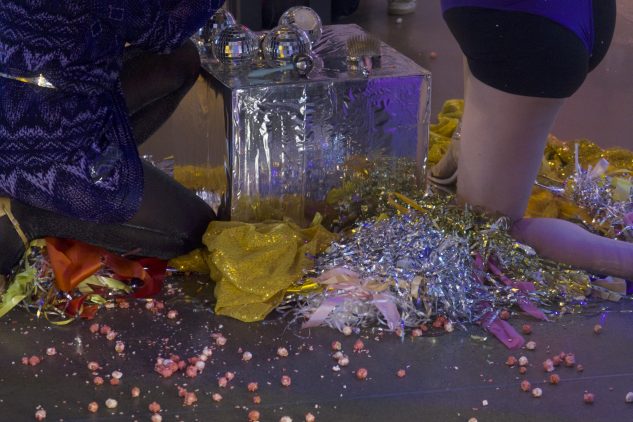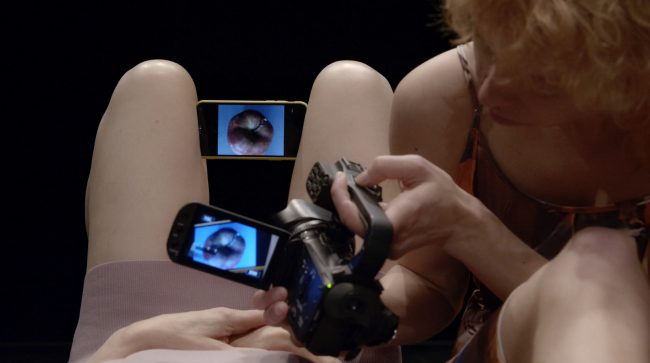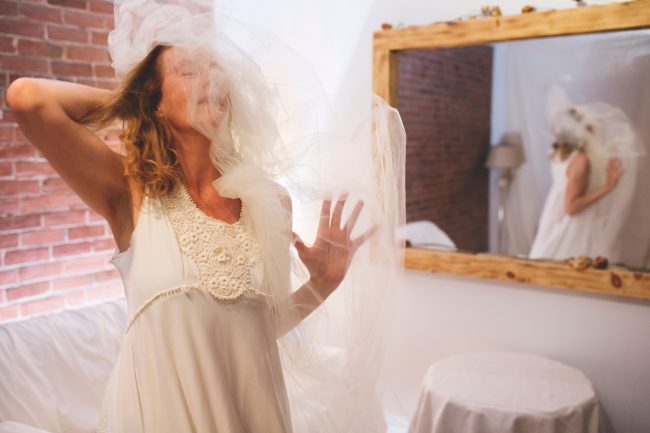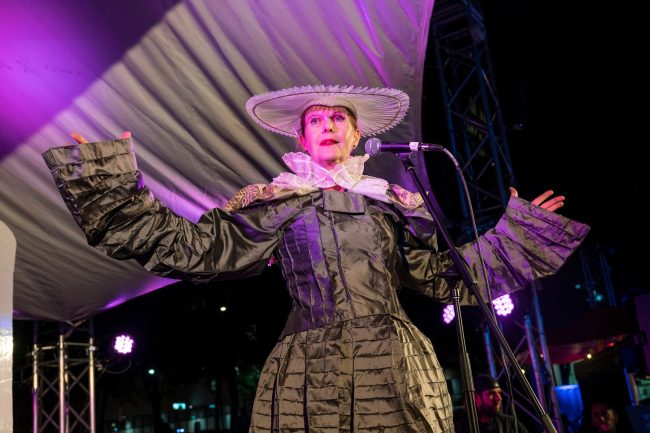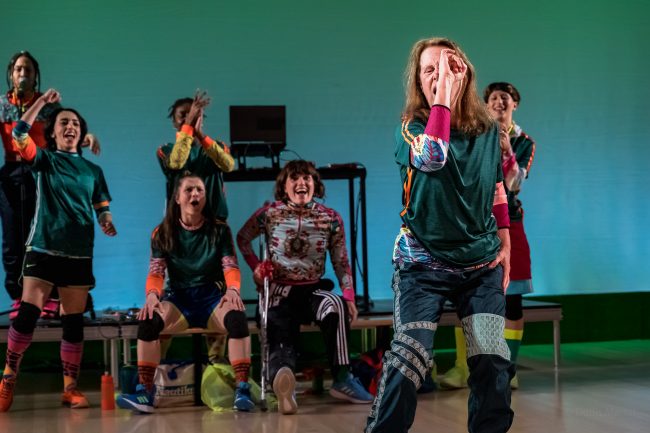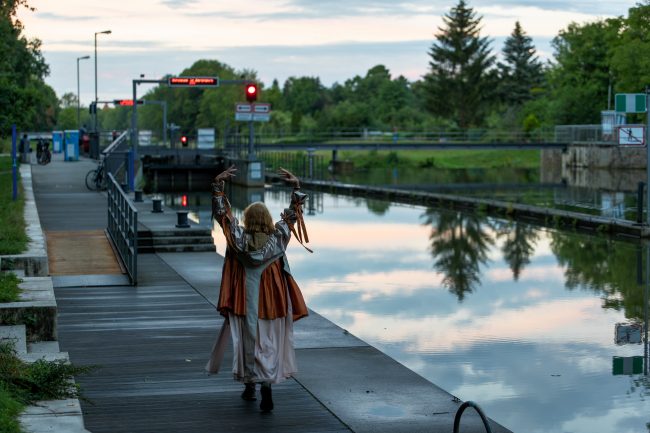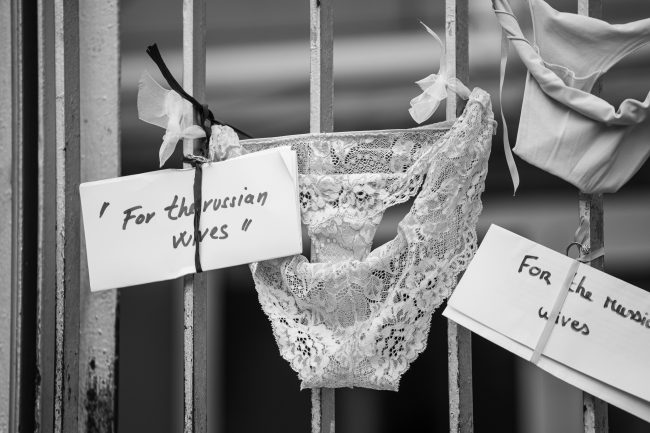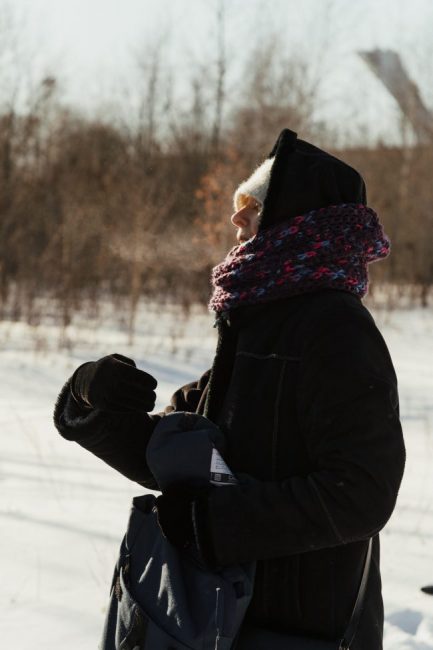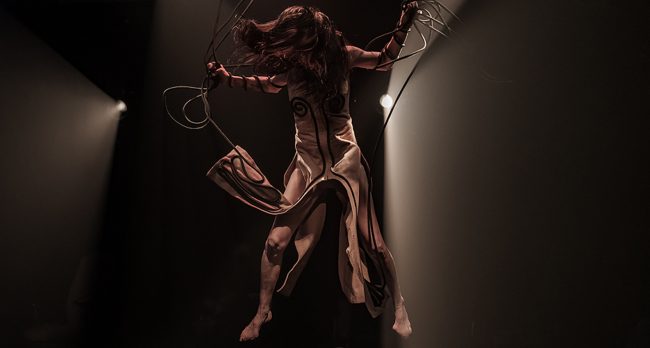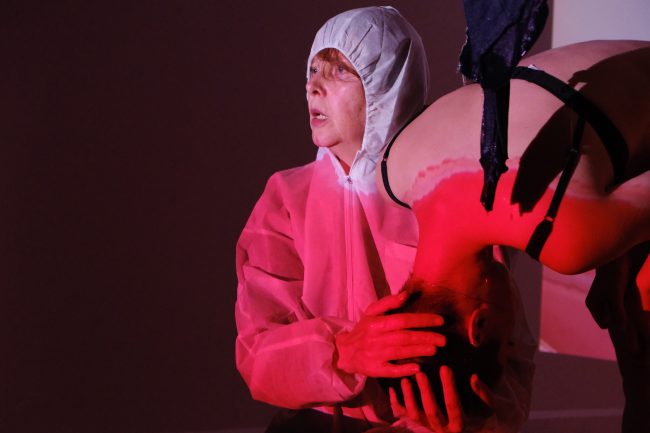Between visual arts and performance, four characters exist in a space and time loop framed by limitations that are the result of the chronic illness they have in common. Semi-resigned yet hopeful, they discover meaning and purpose by putting on a show about their lived experiences.
Semi-resigned to their predicament, they decide to make their lived experiences legible by putting on a show, in the hopes that this will end up breaking the rut they are stuck in. The Artist, the Timekeeper, the Cellophane, and the Clown—collectively negotiate with their endeavour, challenging the differences that set them apart.
Entre art visuel et performance, quatre personnages vivent dans une boucle spatiotemporelle formée par des limitations liées à leur maladie chronique commune. À demi résignés et cependant habités par l’espoir, ils font émerger un sens et un but en montant un spectacle sur leur vécu. À demi résignés à leur situation, ils décident pourtant de mettre en lumière leur vécu en montant un spectacle, dans l’espoir que cela les fera sortir de l’ornière. Les quatre personnages – l’Artiste, le Chronométreur, le Cellophane et le Clown –, en négociant collectivement leur entreprise, remettront en question ce qui les distingue.
Critique par Mario Cloutier:
For Everyone Stuck Chasing the Clock : Le Malade non imaginaire
Concept, Text, Set Design, Props, Choreography, Music, and Direction
Chloë Lum & Yannick Desranleau
Performers
Jacqueline van de Geer, Maxine Segalowitz, Lior Maharjan, Michael Martini
La Chapelle, Montreal 2025
credit David Wong
Jacqueline van de Geer & Annie Baillargeon presented a performance about sisterhood that celebrates the joy and brilliance of their six-month residency.
As creative sisters, they revealed the pleasure of creating together around the artifices and clichés of femininity imposed by our society.
In honor of feminist performance practices, the title of their creation refers to Carolee Schneemann’s famous 1964 performance Meat Joy.
The duo took their inspiration of Meat Joy’s movement cycles as well as from their own creative process at the PHI residency in which during six moth an exhibition and several performative events were created, solo and as a duo.
As part of the PHI Montréal residency, in partnership with the Conseil des arts et des lettres du Québec (CALQ), the two artists of the 2023-2024 cohort, Jacqueline van de Geer (Montréal) and Annie Baillargeon (Québec), collaborated with the PHI Foundation for Contemporary Art to develop and present two public engagement projects:
Becoming Sparkling by Jacqueline van de Geer and Cosmologie of Mutations by Annie Baillargeon.
Meet Joy and Glittering Gloss was presented as the closing event of the duo exhibition.
credit: Daniel Fistet
]]>THE PLOT is a video performance that borrows from the aesthetics of a téléthéâtre while also cutting through an image-scape more reflective of the digital and social media era. The performance features three people reiteratively telling each other about a hypothetical movie plot that also involves three characters: the Protagonist, the Writer, and the Voice Actor (who eventually becomes the Dancer). The movie plot is a psychological thriller and pseudo-revenge fantasy involving artistic collaborators who become competitors and suggestively lovers. Throughout, themes of miscommunication, desire, and consent surface and disappear.
Using multiple grades of images, captured by multiple camera types, THE PLOT switchbacks between auto-filming, which places the viewer on the inside of the performance, and an outside, more cinematic camera that acts at different moments as a witness or voyeur. These syncopated proximities look for ways to articulate the feeling of seeing and the feeling of being seen.
The Teller, active and alive, reiteratively tells the story that the three characters (The Protagonist, The Writer and The Voice Actor, who eventually becomes the Dancer) perform like an inherited emerging pattern. These characters, interrupted and never fully recovering themselves, make tremble at every distinction the stability of entities and concepts. In other words, the process of differentiation of their identities is in correlation to the indeterminacy of their relation, in which they are distinct and yet not separate. Who came first — the characters or the plot?
There is a tenderness between the three performers/characters and their efforts at telling the story. Faithful to the task, they cradle the opacity of The Source, the profundity of their interdependence and then let it go, over and over, like a breath.
— hanako hoshimi-caines
Credits
Director, video editing: Emma-Kate Guimond
Camera: Isabelle Pauwels
Additional camera: performers
Performers: Jacqueline Van de Geer, Sarah Chouinard-Poirier, Nien-Tzu Weng
Sound recording: Elena Stoodley, Oliver Lewis
Sound design: Elena Stoodley
Sound mixing: Bruno Pucella
Piano composition: Nathan Vanheuverzwijn
Pictures documentation: Paul Litherland
Centre Clark, Montreal
DESEO est un ovni théâtral, Ximena Ferrer, la metteuse en scène nous invite dans une maison, transformée en bordel.
Les spectateurs sont invités à se déplacer de pièce en pièce afin de partir à la rencontre de cinq femmes, aux histoires singulières.
De pièce en pièce, on navigue dans de folles histoires de vie. Chacune de ces femmes se montre captivante et touchante.
Il y a cette jeune femme de 28 ans, enfermée dans sa chambre, qui veut à tout prix retrouver son éros pour vivre pleinement sa sexualité.
Et puis il y a ces deux comédiennes retraitées, deux sœurs, une amusante version des Demoiselles de Rochefort, qui offrent des spectacles de strip-tease tous les soirs.
On part également à la rencontre de cette metteuse en scène qui s’interroge sur ce qu’est la perversion et sur ce qui est tabou ou non en matière de sexualité.
Enfin, au cœur de la maison, on découvre une femme d’un certain âge sobrement installée sur un canapé qui se dévoile dans un monologue rythmé par la folie et la sensualité.
Présenté du 2 au 30 septembre 2023 à la Maison de la rue Fullum.
WestmountMag:
‘A tragicomic piece by Marianella Morena, Phèdre au-dessous des ruines compliments this little collection of plays. With accomplished ease, Jacqueline van de Geer gives voice to the range of emotions surrounding love: infatuation, obsession, hate and despair.’
Avec Alexandrine Agostini, Stéphanie B. Dumont, Catalina Pop, Josée Rivard et Jacqueline Van De Geer
Mise en scène Ximena Ferrer | Assistance à la mise en scène Lesly Velazquez
Textes Jimena Marquez et Marianella Morena (Uruguay), Camila Forteza et Julie Vincent (Québec)
Traduction Ximena Ferrer
Scénographie, éclairages, accessoires Catherine Le Gall et Rodolphe St-Arneault
Designer graphique Maria Noël Ferrer
Production Singulier Pluriel
Credit DavidOspina
CABARET DADA PHÉNOMENA GAMELIN IV
Ce spectacle ludique et poétique, animé par Jacqueline van de Geer (alias Adelaide) et qui réunit des artistes aux disciplines variés, s’inscrit dans la tradition du Mouvement DADA. Il met en vedette l’excentrique duo Glamour Magique, les artistes Mycelium et Hanako Hoshimi-Caines, le duo de Jon Lachlan Stewart et Alexander Winfield, ainsi que les Frères Hermanos Brothers qui exécuteront des numéros de cirque à l’ancienne!
Présenté par Les Filles électriques et Festival Phénomena
Animé par Jacqueline van de Geer
Direction artistique par D. Kimm
Credit Photo : Caroline Hayeur et Sebastien Lose
]]>Qu’est-ce qui différencie un groupe d’une équipe? Dans ce spectacle destiné au public adolescent, cinq femmes se rassemblent le temps d’une partie à la grandeur de leurs expériences réunies. Sont-elles amies, inconnues, adversaires, sœurs de sang ou sœurs choisies? Où sont tes épaules quand tu donnes des coups de pied célèbre les liens de sororité à travers la danse-théâtre et une recherche gestuelle inspirée du soccer. Si la fraternité a longtemps été synonyme de solidarité pour tous et toutes, comment les nuances propres à la sororité peuvent-elles aussi influencer nos liens interpersonnels aujourd’hui?
Poème interprété durant le spectacle
Ce génie, c’est ma soeur
Quand je l’ai vue saigner à se plier en deux
Le ventre condamné par des assauts fiévreux
Le corps humide et pâle, éreinté de douleur
J’ai ressenti son mal en pensant: c’est ma soeur
Quand je l’ai vue chargée de mille poids trop lourds
Assaillie, débordée du jardin à la cour
J’aurais juré qu’en elle, il s’en cachait plusieurs
Mais non, elle était seule. Elle assurait, ma sœur.
Quand je l’ai vue blessée par l’insulte et la haine
Qui pourrissent au fossé de la bêtise humaine
J’ai voulu la chérir et la couvrir de fleurs
Pour conjurer le pire. On fait ça, entre soeurs
Mais quand je la vois forte avec le poing levé
Déverrouiller les portes et battre le pavé
Reléguer l’impossible au rang des vieilles peurs
Je la trouve invincible, invincible ma soeur
Quand je la vois nature, animale et sauvage
Épouser le futur au rythme de son âge
Creuser sa propre terre et trouver son bonheur
J’en serais presque fière: ce génie, c’est ma soeur
Quand je l’entends chanter l’urgence et l’absolu
L’amour, la liberté, les carcans révolus
Les grands vents dans les blés, les sorcières en chaleur
Je veux lui ressembler! et par chance, c’est ma sœur.
Texte de Jeanne Cherhal, tiré du recueil collectif Sororité dirigé par Chloé Delaume
credits: Vanessa Fortin et Denis Martin
]]>Three dancers sing, move, dance and play with the bridge, on the bridge and about the bridge in the twilight of sunrise and sunset.
Dämmer[blau] is dance performance by Mona Louisa-Melinka Hempel & friends, performed at dawn and dusk on the Probsteig Bridge (Leipzig, Germany).
In the twilight of the sunrise in the early morning and the sunset in the late evening, details seem out of place, our senses are sharpened, the time has stopped.
In these circumstances, we set out in search of the magical details of everyday life and experience how how our neurons, nerve endings, and body chemicals respond to them.
Where is the physicality of an enthusiastic YES?
Where is the physicality of pebble sounds?
Starting from the transition point “Probsteisteg” on the former site of the provost of the Augustinian monastery St. Thomas (13th century) and the modern reinforced concrete swing bridge construction with pebbles and sharp curves, this performance considers how the physicality of Feelings and reactions can be resistant and in solidarity with the participants.
Artists/Dancers
Roxana Khamg Munoz
Jacqueline van de Geer
Chiara Mila Jason
Melisa Paz Lantadilla a.k.a Gallanegra
Mona Louisa Melinka Hempel
Dämmer[blau] took place in cooperation with Heike Hennig.
Credit Hendrik Pupat
On 10 july 2022, nine women conducted the performance For the Russian wives in front of the russian embassy in Prague. This performance was initiated and guided by Kateryna Mamchut and supported by Artivist’s lab and Meetfactory.
A megaphone, held by Kateryna Mamchut, is blasting information about how russian military is using rape as a dirty weapon in Ukraine.
She is accompanied by eight women on her side, standing in a line, listening, then the nine women put off their underwear, attaching it on the fence together with their wedding rings and a letter, addressed to the russian wives.
“Here are my things, I’m giving them to you voluntarily, just don’t touch the Ukrainian women!”
The women return and they stand in a line in front of the fence again, watching their underwear, their rings and the letters attached to it, and finally they listen one more time to the text, blasting out of the megaphone, before they leave, crossing a bridge, painted in yellow and blue.
“For the russian wives” is dedicated to the wives of the russian military, who are not ashamed to express their hatred for Ukrainians in general, including women and children.
Russian soldiers rape Ukrainian women with brutal cruelty.
Apparently these wives approve of the actions of their husbands. In one of the infamous telephone conversations with the husband-invader his wife said: Go there, rape Ukrainian women and don’t tell me anything. Is it clear? The important thing is to use protection (meaning condom).
Soldiers send to their homes not only household appliances and carpets. They send private items such as worn lingerie, rings and cosmetics. Did this lingerie belonged to the women they raped, are the wives of Russian invaders wearing the rings of Ukrainian girls and women?
Credits: Josef Rabara.
]]>Comment l’échange verbal nous chorégraphie-t-il ?
Quatre individus tentent d’y répondre à travers des jeux basés sur des actes de langage, impliquant différentes paroles codées et des défis de communication.
Le quatuor explore l’influence du public, il l’engage dans des échanges inattendus et parfois imperceptibles. Au-delà du plaisir qu’elles suscitent, les épreuves, jonglant entre devinettes et joutes sportives, font advenir la réunion et l’organisation d’un groupe.
En créant des liens inopinés, Direction assistée révèle des moyens de nous mettre en relation. Subversifs, les échanges éprouvés dans un espace chorégraphique transforment nos perceptions.
How are we choreographed by verbal communication?
Four people attempt to answer this question through language games with a series of speaking codes and communication challenges.
The quartet explores the spectators’ influence and engages them in surprising and sometimes imperceptible conversations. Juggling riddles and verbal jousts, the tasks inspire pleasure while uniting and organizing the group.
Drawing unexpected connections, Direction assistée reveals ways of entering into relation. Our perceptions are transformed through this choreography of subversive exchanges.
Idéation et chorégraphie Brice Noeser
Performance sur scène
Karina Iraola
Jacqueline Van de Geer
Maria Kefirova
Elinor Fueter
Premiered at La Chapelle, Montreal 24 february 2022
Credit: Thibault Carron
]]>OPEN FIRE | FEU OUVERT is a furtive, political, symbolic and poetic work conceptualized by Marie-Claude Gendron. Involving the artist and many members of the Montréal action art community, the group feeds a fire—daily, stealthily and anonymously—keeping the fire burning continuously over the course of the last two weeks of January.
OPEN FIRE | FEU OUVERT is an attempt to revive the invisible link that unites us through the practice of action art. Confined, for the most part, to the home, Marie-Claude Gendron’s wish is to propose an outside simple action that involves the participation of artists in whatever way is possible given their respective means and motivation. The resolution is to foster being together, even in an abstract and active way in the imagination.
The closing event for OPEN FIRE | FEU OUVERT was a co-presentation with VIVA! Art Action.
With the particiation of fire-keepers:
Alexis Bellavance
Laurence Beaudoin-Morin
Catherine Bodmer
Caroline Boileau
janick burn
Sylvie Cotton
Anne Florentiny
Pierre Gauvin
Léo Gaudreault
Stéphane Gilot
stvn Girard
Katherine-Josée Gervais
k.g. Guttman
Michelle Lacombe
Frédérique Laliberté
arkadi lavoie lachapelle
Julie-Isabelle Laurin
Helena Martin Franco
Diyar Mayil
Rhonda Meier
François Morelli
Florencia Sosa Rey
François Rioux
Jacqueline Van De Geer
Stephanie Nuckle
credits: Manouska Larouche & Marie Claude Gendron ]]>
Trajectoires explore les nuances de l’être humain, en une série de rencontres et de dialogues à propos de ce qui existe aussi en chacun de nous. Différents parcours géographiques et émotionnels à emprunter y sont proposés afin d’entrer en contact avec l’autre. Huit femmes et hommes y incarnent plusieurs archétypes, puissants et vulnérables à la fois – en une installation performative de six tableaux ; Narcisse, Skennen’kó:Wa, Magna Mater, Anima, Animus, Androgyne. À travers le public déambulant, ils prennent vie, puis s’éteignent, chacun avec force et pudeur. Au-delà des tableaux qu’ils symbolisent, leurs seules présences et diversités témoignent de toutes leurs richesses; âges, sexes, ethnicités, origines, genres, orientations, personnalités, etc. Récits énigmatiques, voies singulières, Trajectoires brouille ainsi certains codes entre spectateurs et performeurs pour créer un être-ensemble capable d’ouvrir l’éventail de nouvelles approches sensibles et transculturelles. Trajectoires évoque ici la complexité et le foisonnement de la psyché humaine – et invite à la réflexion.
Trajectories explores the many shades of human being, in a series of encounters and dialogues of what exists in each of us. Different geographic and emotional paths to follow, in order to come into contact with each other. Eight women and men embody several archetypes, powerful and vulnerable at the same time – in a performative installation of six scenes; Narcissus, Skennen’kó: Wa, Magna Mater, Anima, Animus, Androgynous. Through the audience wandering, they come to life, then die, each with strength and modesty. Further than the scenes they symbolize, their simple presence and diversity is a testimony of their richness: age, sexe, ethnicity, origins, genres, orientations, personalities, etc. Enigmatic narratives, singular paths, Trajectories thus blurs certain codes between audience and performers to create a being-ensemble capable of opening the range of new sensitive and transcultural approaches. Trajectories evokes the complexity and the profusion of the human psyche – and invites to rethink.
Crédits : Chorégraphe, dramaturge, concepteur des costumes : Élian Mata | Artistes-performeurs et collaborateurs à la création : Toshiro Arthur Kamara, Jacqueline van de Geer, Jérémie Brassard, Barbara Kaneratonni Diabo, Gabrielle Surprenant Lacasse, Thomas Wilkinson Fullerton, Anne Flore de Rochambeau, Stevens Simeon | Narration : Kawennotas | Costumes : Marilène Bastien | Coupe et couture : Genevièeve Bouchard, Marianne Thériault | Coupe : Gilles-François Therrien, Martine Dubé | Couture : Pricilla Collin, Isabelle Ouimet | Teinture : Chloé Giroux-Bertrand | Vidéastres : Vickie Grondin, Carl Beauchemin | Photo’s : Vanessa Fortin, David Wong | Décor : Samuel Thériault | Conseillère artistique : Jessica Serli.
]]>In an old abandoned bank a performance happens, a sex worker, a bunch of wild young women, a ritual with water and fire, writing the same letter over again, confessions and a woman washing clothes and telling stories of abuse and power, al inspired by the following text:
Je brise. Je casse. Je défonce. Je dégueule. Je vomis. Je régurgite. J’orgasme. Je rampe. Je suce. Je mords. Je cris. Je révulse. J’anéantis.
Je pourrais te détruire.
Pourrais-je te détruire?
Sans me détruire?
Sans tout détruire?
Détruire nous allons
Détruire ces vagues qui nous submergent
De colère, de rage, de honte
Briser le cycle
Breaking the waves.
Collaboration avec Ménades contemporaines,Montreal.
credits: Samantha Blake et Antoni Michalik


